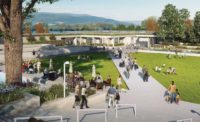I grew up during the Civil Rights movement of the 1960s and, like many others of my generation, I like to think I am well-informed about the history of race in the United States. But, actually, no. I’m constantly finding gaps, small and large, in my knowledge of racial politics and its profound impact on the lives and experiences of so many fellow citizens.
Recently, I was in Detroit, a city I have visited all my life, and for the first time, I heard about “the Wall.” Built of concrete, 6 feet high and 1 foot thick, and extending for a half-mile in the northwest corner of the city, it was constructed in the early 1940s to keep African Americans out of a planned new subdivision for whites and satisfy the FHA (Federal Housing Authority), which otherwise wouldn’t guarantee a loan to the developer.
Today, on both sides of the wall are neighborhoods that are largely African American: the gabled-roof houses of the original development on one side and the tidy rows of more recent one-story brick ranch houses on the other. The wall itself is now a riot of color, adorned with murals and slogans, and paintings of figures such as Harriet Tubman and Rosa Parks. It stands as just one physical reminder of segregation and the obstacles African Americas have faced finding and investing in housing.
The story of racism isn’t usually so clearly marked in the built environment. The prevalence of lynching in 19th- and 20th-century America is an ugly chapter of history from which people recoil, and the particular victims of its terrifying vigilantism have largely been forgotten. But, last year, the Equal Justice Initiative, a nonprofit based in Montgomery, Alabama, released a report documenting 4,000 lynchings that took place between 1877 and 1950. The group has collected soil from many of the actual sites of these murders, and is now planning to build a memorial in Montgomery, designed in collaboration with the MASS Design Group of Boston. The pavilion will include 800 6-foot columns representing the counties where lynchings took place, with the victims’ names inscribed on them.
The effort to introduce specifics—names, places, and objects—into the sweep of historical events is a powerful tool for teaching. That is abundantly clear in the new National Museum of African American History and Culture, a vessel of evocative objects and individual stories, which opened last month in Washington, D.C. The architecture, by David Adjaye with Phil Freelon and the Freelon Adjaye Bond/Smith Group, is striking, particularly the three-tiered bronze-colored screen that wraps the entire building, inspired by the corona or crown of a Yoruban column from West Africa. Inside, the history begins with Africa, with the visitor traversing down handsome wide ramps to the softly lit spaces of the lowest levels of the museum, where an often harrowing narrative journey starts and moves through the Middle Passage and the cruelties and violence of domestic slavery to the institutionalized racism of Jim Crow. It is as if so much African American history has been buried and is now emerging into the light, capped by the triumph of African American achievement—or dominance—in every aspect of our culture and society.
London-based Adjaye had previously worked in Washington, designing two branch libraries over the last decade. From meeting people in those neighborhoods, he learned that many African Americans don’t feel part of the country’s history. He was “charged” by that, he says, while designing the building.
At the media preview for the museum, I overheard someone ask a curator, “What would a white kid get out of this?” It was an unfortunate question, but one that this new institution will begin to answer. “This is not a black museum,” the director, Lonnie Bunch, told The New Yorker. “This is a museum that uses culture to understand what it means to be an American.” Not only will it help bridge the knowledge gap, but its presence on the National Mall, in the shadow of the Washington Monument, sends an unmistakable message that we have one vast, sprawling history, and all of us are part of it.









Post a comment to this article
Report Abusive Comment